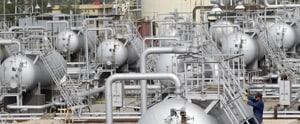GCC REGIONAL REPORT: OIL MARKETS
By Gordon Platt
Global politics, supply dynamics and the fiscal needs of the GCC’s governments are combining to cloud the prospects for oil prices .
 |
Oil prices have been volatile in recent months, reacting to political unrest in the Middle East and North Africa and changes in the outlook for the global economy, but hydrocarbon prices will remain high this year, leading analysts in the Arab Gulf say. This is good news for the GCC economies as they step up spending programs to create job opportunities and improve the welfare of their populations.
In Saudi Arabia, the world’s largest oil exporter, local energy consumption is growing rapidly, in step with the economy, says Brad Bourland, chief economist and managing director of proprietary investment at Riyadh-based Jadwa Investment. “If the growth in Saudi oil consumption continues at the current rate of 7% annually and the kingdom’s overall oil output stays roughly the same as it is, then within 20 years the country will have no oil left to export,” Bourland says.
 |
|
Bourland, Jadwa: “Above $100 a barrel you get demand destruction” |
The logical range for the oil price, based on fundamentals, is $80 to $95 a barrel, according to Bourland. “The $80 floor is determined by the cost of bringing new production online, such as from tar sands,” he says, adding that OPEC producers, including Saudi Arabia, need $80-a-barrel oil to meet their fiscal requirements.
“Above $100 a barrel, you start to get demand destruction,” Borland says. With some inflation, the $80 to $95 price range should go up by as much as $5 a barrel per year, he says.
There are a number of other factors that could affect oil prices in the next few years. For one thing, Iraq will become a co-leader in oil production, along with Saudi Arabia, as it ramps up production and increasingly flexes its muscle in OPEC, Bourland says. The US State Department estimates that Iraqi oil production will increase by 25% to 35% this year to 3 million barrels per day, which would allow for exports of 2.4 million bpd, the highest in two decades.
Another potential game-changer is the growing use of shale gas, an increasingly important source of natural gas in the US. “If natural gas can find an increased role as a transportation fuel, this could have a meaningful impact on oil demand in the coming decades,” Bourland says. The US is now a net exporter of natural gas, and the big terminals built on the US coasts to receive LNG shipments from the Middle East and elsewhere are now being turned into export terminals, he says.
Meanwhile, Saudi Arabia continues to subsidize domestic gasoline prices, which average about 45 cents a gallon, among the lowest in the world. The kingdom is using its low energy costs to promote the development of petrochemical and plastics industries. The kingdom’s plastics exports rose by 79% last year to $11.2 billion.
Easing Oil Demand
Saudi Arabia is planning to build 16 nuclear reactors over the next 20 years, at a cost of more than $100 billion, to keep up with its rapidly rising energy needs, according to Abdul Ghani bin Melaibari, coordinator of scientific collaboration at King Abdullah City for Atomic and Renewable Energy. He told a conference in Jeddah that each reactor would cost about $7 billion. Melaibari said the kingdom would launch a 20-year plan in 2011 to introduce renewable, clean energy.
In June, National Bank of Kuwait boosted its forecast for Saudi Arabia’s GDP growth this year to 6.9% from 4.2%, which would make it the region’s second-fastest-growing economy after Qatar. After stagnating for most of last year, the kingdom’s crude oil production jumped 7% in the three months to February 2011, NBK says. This partly reflects increases in broader OPEC production in response to surging oil prices, as well as a move to partially offset the drop in Libya’s oil output.
“The price of oil will stay around $100 for the coming year,” says Randa Azar-Khoury, group chief economist at National Bank of Kuwait. The price could range between $90 and $120 a barrel under various scenarios, she says, noting that strong demand is coming from emerging markets. “Demand should remain on the high side during the summer months, and China will face its most severe power shortages,” Azar-Khoury says. Global oil inventories are low in terms of general historic trends, she says.
“On the supply side, Libya is out of the market, and non-OPEC producers are unable to fill the gap,” Azar-Khoury says. “Saudi Arabia accounts for two-thirds of the spare capacity in the market, but it doesn’t produce the same type of light sweet crude that was lost with Libya shutting down.”
Meanwhile, regional consumption is rising in response to population growth and increasing demands from the petrochemicals, plastics and power-generation industries, Azar-Khoury says. “The countries in the region are not conservationists,” she says.
After rising through most of April, oil prices slumped in early May, losing all of the gain made in the previous two months. The declines were part of a broader sell-off among commodities. Silver fell by 26% in just over a week, according to NBK. “However, few analysts are calling an end to the latest spell of high prices, particularly with Libyan crude remaining off the market, OPEC increasing its supplies only cautiously and demand growth in emerging markets remaining strong,” the bank says.
Oil prices have recovered somewhat after May’s 15% plunge, when markets reappraised geopolitical concerns and global growth conditions, according to a report published in June by the economics department of Riyadh-based Samba Financial Group. “Forward-looking supply concerns continue to trump indications that current supply and demand conditions are well balanced, despite the loss of Libyan production,” the report says.
With the overwhelming majority of oil trading now accounted for by financial investors, it was their changing perceptions of geopolitical risks and global economic prospects that caused prices to drop steeply, Samba says. For now, the bank is holding firm on its $95-a-barrel West Texas intermediate (WTI) average projection for 2011. It says there remains some potential for even higher prices, since fundamentals could tighten in the second half of the year.
Oil prices rose 2% on June 8 to above $100 per barrel, after OPEC said it could not reach agreement to raise production at its quarterly meeting in Vienna. Although Saudi Arabia says it will pump as much oil as the world market needs, OPEC ministers said there was no consensus on production limits.
One factor affecting OPEC’s negotiations was an apparent shift by Saudi Arabia away from its long-held target of $70 to $80 a barrel, to an unspecified figure below $100 a barrel, according to Samba. In common with other GCC producers, Saudi Arabia wants to secure prices high enough to support its expanding domestic-spending program, but not so high as to threaten global economic growth.
“This will be a difficult balancing act,” according to Samba. “As long as the global economy, and particularly key emerging markets such as China and India, continues to grow, then concerns will remain about whether the oil supply can keep up.”
|
|
||




